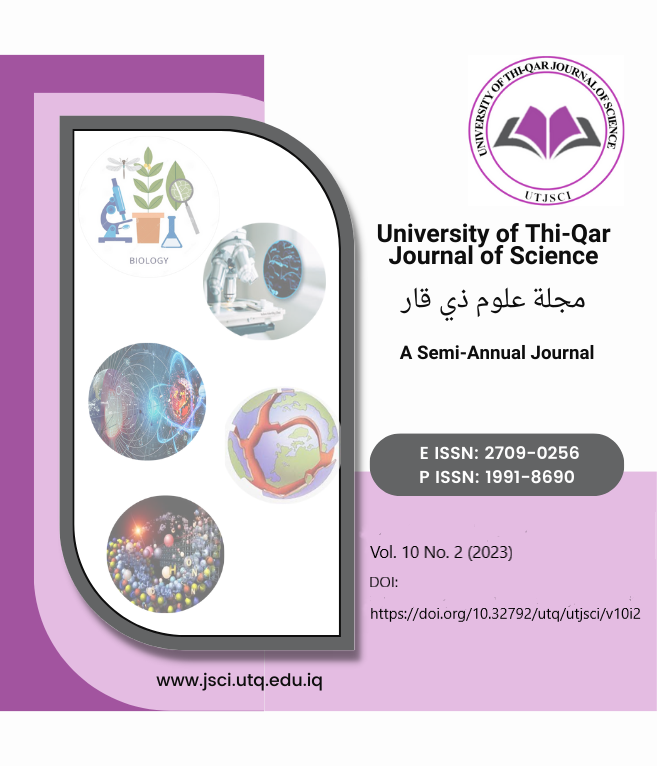Ethnobotanical Survey of Plants used in Treatment of Haemorroids in North-Central Nigeria
DOI:
https://doi.org/10.32792/utq/utjsci/v10i2.1112Keywords:
haemorrhoids, Ethnobotany herbalists, traditional medicinal practitioners, accepted, effectivenessAbstract
An ethnobotanical survey was conducted to identify and document the plants used in the treatment of haemorrhoids in North-Central, Nigeria. A total of three hundred (300) respondents among whom were herb sellers, herbalists, and traditional medicinal practitioners were consulted and interviewed with the help of structured questionnaires to collect data on the plant species from them. Data were represented tables, bar and pie charts and analyzed using descriptive statistics (frequencies and percentages). A total of forty-eight (48) plant species from twenty-seven (27) families were found to be useful in treatment of haemorrhoids in the area under the study. The most prominent among these being members of the family Euphorbiaceae with 4 species, indicating the utmost importance of this family in the cure of haemorrhoids. Followed by families Amaranthaceae, Compositae, Fabaceae and Meliaceae with 3 species each. The plants were identified using botanical, and common names, and the parts of the plant used were also identified. The study revealed that traditional medicinal practices were widely accepted among the people in the study area, probably because they believed in their effectiveness. The plant parts used ranged from root (8.30%), whole plants (8.30%), leaves (43.80%), stem bark (4.24%), bark (10.43%), stem (6.25%) to fruits, young leaves, stem bark leaves, bulb, fruit cub, juice, leaves and juice, shaft of seeds, and bark and leaves at 2.08% each. Further research should be carried out to identify more plant species in the area that can be used to treat haemorrhoids.
Received: 2023-09-05
Revised: 2023-10-19
Accepted: 2023-10-27
References
M. O. Soladoye, M. O. Adetayo, E. C. Chukwuma and A. N Adetunji
“Ethnobotanical Survey of Plants Used in the Treatment of
Haemorrhoids in South-Western Nigeria”, Annals of Biological Research,
vol. 1 (4), pp. 1-15, 2010,
E. N. Sholikhah, “Indonesian Medicinal Plants as Sources of Secondary Metabolites for Pharmaceutical Industry”, J. Med. Sci., vol. 48, pp. 226–39, 2016.
World Health Organization (WHO) 2013 WHO traditional medicine strategy: 2014-2023 (World Health Organisation)
M. Bolson, S. R. Hefler, C. E. I. Dall’Oglio, J. A. Gasparotto, J. E. L. Cardozo, “Ethno-medicinal study of plants used for the treatment of human ailments, with residents of the surrounding region of forest fragments of Paraná”, Brazil J. Ethnopharmacol, vol. 161, pp. 1–10, 2015.
P. R. W. Astana, U. Nisa, “Analysis of Traditional Medicine Formula for Hemorrhoid In Java Island; Ethnopharmacology Study”, RISTOJA J. Ilmuefarmasian Indones, vol. 16, pp. 115–23, 2018.
M. D. C. Surboyo, I. Arundina, R. P. Rahayu, D. Mansur, T. Bramantoro,
“Potential of Distilled Liquid Smoke Derived from Coconut (Cocos nucifera L) Shell for Traumatic Ulcer Healing in Diabetic Rats”, Eur. J. Dent., vol. 13, pp. 271–9, 2019.
P. Singh, R. L. Khosa, G. J. K. Mishra,
“Pharmacognostical evaluation of aerial parts of Graptophyllum pictum (L.) Griff. (Syn: Justicia picta Linn.): A well-known folklore medicinal plant”, Anc. Sci. Life J., vol. 34, pp. 223–9, 2015.
O. A. Akande, A. Buochuama, S. A. Alaye, A. B. Shuaib, A. M. Mohammed, “Ethnobotanical Survey of Medicinal Plants amongst Kanti Community in Mashegu Local Government Area of Niger State, Nigeria”, International Journal of Innovative Biosciences Research, vol. 6 (1), pp. 20-27 2018.
M. Budiarti, A. Maruzy, R. Mujahid, A. N. Sari, W. Jokopriyambodo, T. Widayat, S. Wahyono, “The use of antimalarial plants as traditional treatment in Papua Island”, Indonesia Heliyon, vol. 6, pp. 1–10, 2020.
G. Demie, M, Negash, T. Awas, “Ethnobotanical study of medicinal plants used by indigenous people
in and around Dirre Sheikh Hussein heritage site of South-eastern Ethiopia”, Journal of Ethnopharmacology, vol. 220, pp. 87-93, 2018.
M. O. Faruque, S. B. Uddin, J. W. Barlow, S. Hu, S. Dong, Q. Cai, X. Li, X. Hu, “Quantitative Ethnobotany of Medicinal Plants Used by Indigenous Communities in the Bandarban District of Bangladesh. Frontiers in
Pharmacology. Vol. 9, pp.40, 2018.
M. D. Miara, H. Bendif, M. A. Hammou, I. Teixidor-Toneu, Ethnobotanical survey of medicinal plants used by nomadic peoples in the Algerian steppe. Journal of Ethnopharmacology, vol. 219, pp. 248-256, 2018.
K. P. Lee, G. W. Sudjarwo, J. S. Kim, S. Dirgantara, W. J. Maeng, H. Hong, “The anti-inflammatory effect of Indonesian Areca catechu leaf extract in vitro and in vivo.” Nutr. Res. Pract., vol. 8, pp. 267–71, 2014.
S. Naher, M. I. Akter, S. M. M. Rahman, S. R. Sajon, MA. Aziz, “Analgesic, anti-inflammatory and anti-pyretic activities of methanolic extract of Cordyline fruticosa (L.) A. Chev. Leaves”, J. Res.Pharm., vol. 23, pp. 198–207, 2019.
A. Kalaiarasan, S. Ahmed John, “Phytochemical screening and Antibacterial activity of Sida cordifolia L. (Malvaceae) leaf extract”, Int J Med Res., vol. 1(2), pp. 94-98, 2010.
Elfita, Mardiyanto, Fitrya, J. E. Larasati, Julinar, H. Widjajanti and Muharni, “Antibacterial activity of Cordyline fruticosa leaf extracts and its endophytic fungi extracts”, Biodiversitas, vol. 20, pp. 3804–12, 2019.
M. S. Khan and M. S. Akhter, “Antibacterial and cytotoxic activities of Areca catechu L. (betel nut)”, To Chem. J., vol. 5, pp. 55–68, 2020.
R. Rahimi, M. Abdollahi, “Evidence-based Review of Medicinal Plants Used for the Treatment of Hemorrhoids”, International Journal of Pharmacology, vol. 9 (1), pp. 1-11, 2013.
M. N. Chukwu, M. S. Ayodele and U. P. Udeozor, “Ethnobotanical Survey of Medicinal plants used in treatment of Haemorrhage in Abuja Municipal area Council
(AMAC) of the Federal Capital territory”, Confluence Journal of Environmental Studies, Vol. 13 (1), pp. 60 – 69, 2019.
Downloads
Published
License
Copyright (c) 2023 University of Thi-Qar Journal of Science

This work is licensed under a Creative Commons Attribution 4.0 International License.













